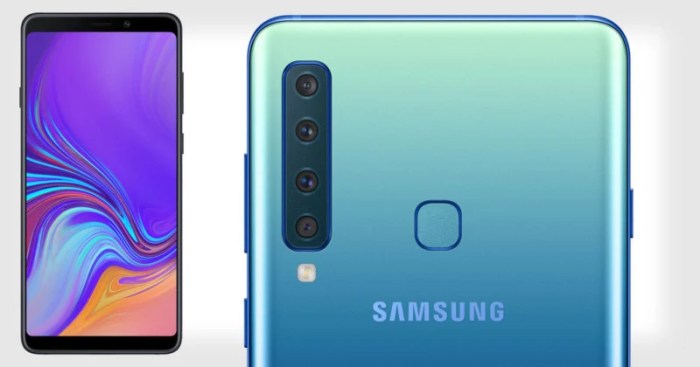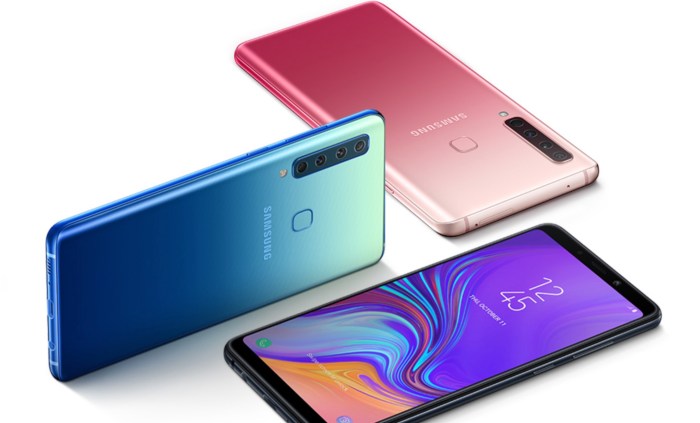Samsung Galaxy A9 Quad Camera Specification
Samsung Galaxy A9 Quad Camera: A Detailed Specification Overview

Source: petapixel.com
Samsung galaxy a9 quad camera specification – The Samsung Galaxy A9, launched in 2018, made waves as one of the first smartphones to feature a quad-camera setup. This in-depth analysis delves into the specifications, capabilities, and user reception of this innovative camera system. We’ll compare it to competitors, examine its image and video quality, and explore the software features that shaped its user experience.
Camera Specifications Overview
The Galaxy A9’s quad-camera system comprised a diverse array of lenses, each designed for a specific photographic purpose. This allowed for versatile shooting options, catering to various photographic needs and styles. The detailed specifications are Artikeld below:
| Lens | Sensor Size | Aperture | Megapixels | Autofocus |
|---|---|---|---|---|
| Wide-angle | 1/2.55″ | f/1.7 | 24 MP | Phase Detection Autofocus (PDAF) |
| Ultra-wide | 1/3.1″ | f/2.2 | 8 MP | Fixed Focus |
| Telephoto | 1/3.4″ | f/2.4 | 10 MP | PDAF |
| Depth Sensor | N/A | f/2.2 | 5 MP | Fixed Focus |
The image processing capabilities leveraged advanced algorithms to optimize image quality, handling dynamic range, color accuracy, and noise reduction effectively. Features like HDR (High Dynamic Range) and scene optimization were integral parts of the processing pipeline.
Comparison with Competitor Phones
Several competitor phones around the same timeframe also boasted quad-camera systems. A direct comparison reveals the strengths and weaknesses of the Galaxy A9’s offering relative to its contemporaries. Note that specific sensor details varied slightly depending on the manufacturer and model.
| Phone | Key Sensor Tech | Image Quality Notes | Notable Features |
|---|---|---|---|
| Samsung Galaxy A9 | 24MP Main, 8MP Ultrawide, 10MP Telephoto, 5MP Depth | Generally good detail and dynamic range, but low-light performance could be improved. | Scene Optimizer, HDR |
| [Competitor Phone 1 – Example: Huawei P20 Pro] | 40MP Main, 20MP Monochrome, 8MP Telephoto | Excellent low-light performance, renowned for its image quality. | Advanced AI scene detection, superior zoom capabilities. |
| [Competitor Phone 2 – Example: LG G7 ThinQ] | 16MP Main, 16MP Wide-angle, 2MP Depth | Strong in daylight conditions, but less impressive in low light. | Bokeh effect, Super Bright Camera. |
The Galaxy A9 held its own against competitors in daylight, offering good detail and color reproduction. However, its low-light performance and zoom capabilities were often cited as areas needing improvement compared to top-tier contenders.
Image and Video Capabilities
The Galaxy A9’s lenses offered diverse capture options. The capabilities are summarized below:
- Wide-angle lens: Capable of capturing high-resolution images (24MP) with good detail and dynamic range in well-lit conditions. Video recording at 1080p at 30fps was standard.
- Ultra-wide lens: Ideal for landscape shots and capturing a wider field of view. Image quality was generally acceptable, but detail could suffer compared to the main lens. Video recording was typically at lower resolutions.
- Telephoto lens: Provided optical zoom capabilities, though the level of zoom was modest compared to some competitors. Image quality at higher zoom levels was noticeably impacted.
- Depth sensor: Assisted in creating bokeh effects in portrait mode. This sensor didn’t contribute directly to image capture but enhanced the software’s ability to blur backgrounds effectively.
- Video Features: Slow-motion video recording was available, but frame rates and resolutions were limited compared to flagship models.
In bright light, images were sharp and vibrant. However, low-light performance showed noticeable noise and a reduction in detail. Videos captured in good lighting showed decent quality, while low-light video suffered from significant grain and reduced clarity.
Software Features and User Interface, Samsung galaxy a9 quad camera specification
The camera app offered a user-friendly interface with various shooting modes, including Auto, Pro, Portrait, and Panorama. The software played a crucial role in enhancing image quality.
- Scene Optimizer: Automatically recognized scenes (e.g., food, landscapes) and adjusted settings accordingly. This resulted in images with optimized colors and contrast.
- AI Scene Detection: Similar to Scene Optimizer, this feature intelligently identified scenes and applied suitable settings to enhance image quality.
- Portrait Mode: Utilized the depth sensor to create a bokeh effect, blurring the background to emphasize the subject. The quality of the bokeh effect varied, sometimes resulting in inaccurate blurring around hair or edges.
These software features significantly impacted the final image output, often improving color accuracy, contrast, and sharpness. However, over-processing in some cases could lead to unnatural-looking images, particularly in low light.
User Experience and Reviews

Source: thegadgetflow.com
User reviews were generally positive, praising the versatility offered by the quad-camera system. However, some shortcomings were consistently noted.
- Strengths: Versatile shooting options, good image quality in bright light, user-friendly interface.
- Weaknesses: Inconsistent low-light performance, limited zoom capabilities, occasional over-processing by the software.
These user experiences largely align with the technical specifications. While the multiple lenses provided versatility, the sensor sizes and aperture values suggested limitations in low-light and zoom performance, as reflected in user feedback.
FAQ Summary: Samsung Galaxy A9 Quad Camera Specification
What is the maximum video resolution the Samsung Galaxy A9 can record?
The maximum video resolution varies depending on the lens used, but typically reaches up to 4K UHD resolution.
Does the Samsung Galaxy A9’s camera have optical image stabilization (OIS)?
The Samsung Galaxy A9’s standout feature was undoubtedly its innovative quad-camera setup, offering impressive versatility for photography enthusiasts. Understanding its full capabilities requires looking at the broader phone specifications, and for detailed information on the overall device, you might find the samsung galaxy a9 pro specification 2019 helpful. Returning to the quad-camera, its performance and image quality remain key aspects of the A9’s legacy.
No, the Samsung Galaxy A9 did not feature OIS on any of its lenses.
How does the depth sensor contribute to the overall camera experience?
The depth sensor enables accurate depth mapping, crucial for creating bokeh effects (blurred backgrounds) in portrait mode and improving the overall accuracy of focus.
Can the Samsung Galaxy A9 shoot RAW images?
While not explicitly stated in all specifications, many reviews suggest that the Galaxy A9 does support RAW image capture in certain modes.





















